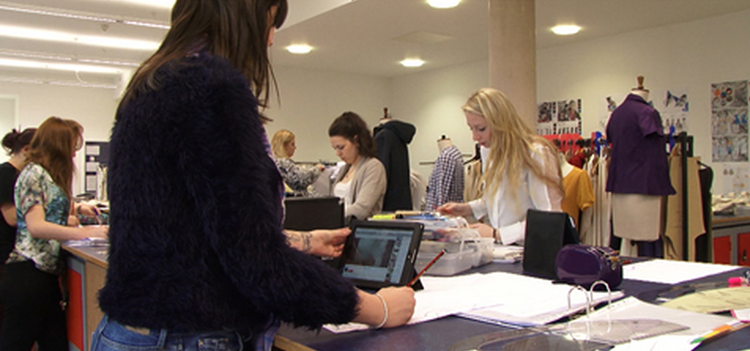- Uncategorized
Using Lecture Capture Technologies to Deliver Compelling Video Feedback to Students
When your students study a highly visual subject – rather than one that relies on reading and writing text – it stands to reason that text-based assessment and feedback may not be the best way to create the most engaging learning experience. This raises a number of questions for learning practitioners – chiefly, if a text-based approach isn’t perfectly matched to certain disciplines, then what medium would be? This is a question we’ve been thinking about extensively at the University of Derby – most specifically in relation to our undergraduate Fashion programme.
We’re justifiably proud of our fashion course at Derby – this month alone, one of our BA (Hons) Fashion Studies students was awarded the accolade of ‘Young Designer’ at the St Andrews Young Designer Awards (YDA) – the second year in a row one of our students has been recognised with this honour. Interestingly, her collection was based around the idea of integrating technology into fashion and this is exactly what we’ve been doing on a pedagogical level too, through our Flexible Feedback Project. This project explored how lecture capture technologies, embedded within our Virtual Learning Environment, could be used to provide 1st and 2nd Year Fashion students with video feedback, accessible through their own devices at times and in locations of their choosing. We wanted to use as many of our existing systems and processes as possible – and this included Panopto, which is our core solution for recording lectures.
As Media Adviser in the Media Production and Support Team at the university, I had been keen to use Panopto for more than just lecture capture for some time and this project was the perfect opportunity to experiment. I could see a lot of potential to use Panopto’s iPad app so that staff could capture ‘now moments’ of student-tutor interaction which could then be shared with students for their further growth and development. I also wanted to use technologies like visualisers with Panopto to record real-time demonstrations of practical student activities. Using Panopto offered us the flexibility to record using a range of devices coupled with a robust, secure system which complied with our institutional data governance policies. Staff also didn’t need to do any file handling or processing, which was seen previously as a roadblock in the adoption of audio/visual feedback. Throughout I worked closely with colleagues like Glenn McGarry (our Learning Technology Developer), Charlie Davis (our Learning Technology Advisor) and Ann Draycott (a Senior Fashion Lecturer and Learning and Teaching Advisor in Design) to create a process that would give us stimulating and accessible learning resources.
From the outset of the project, the course leader Ann made it clear that she wanted to produce materials that supported students before, during and after face-to-face sessions. To help fulfil this aim, we created video content for the following main purposes:
- Demonstrative practical tutorials for self-study purposes, both in and out of class
- Student-tutor feedback conversations and student presentations for post-session reflection
Students were also asked to maintain reflective blogs within our VLE to both demonstrate their skills and provide a safe space to speak to Ann and other lecturers about any issues with their work.
Panopto was used for the capture and distribution of the student-tutor feedback conversations. This was done using Panopto’s iPad app and then pushed to individual student feedback folders within Blackboard so that learners could access them whenever convenient using their own devices. Once students were used to this approach, they saw a lot of value in it, one learner commenting, “[I] found the videos really useful. Particularly the video of our personal feedback as it’s easier to refresh your memory from watching this.”
However, there was a period of adjustment as students became acclimatised to being filmed. It is often assumed that students are completely comfortable with the idea of being recorded but while this may be true in a personal, informal capacity with their friends, it’s not necessarily the case when it comes to the formal learning process. One of our key lessons learned was to be as clear and upfront with students as possible about our learning methodologies and the technologies that will be used to support these teaching approaches so that they are comfortable.
Another key insight we gained is that while students liked being able to access the video resources via a range of devices at times which suited them, the quality of the knowledge shared with them by the lecturer was still the most important thing. Technology can augment and enhance the learning process, but direct interaction with a subject matter expert will always be irreplaceable!
If you want to find out more about how Panopto is being used to support video feedback and student recording, in addition to lecture capture, you can contact one of the Panopto team and request a demo for more information.



